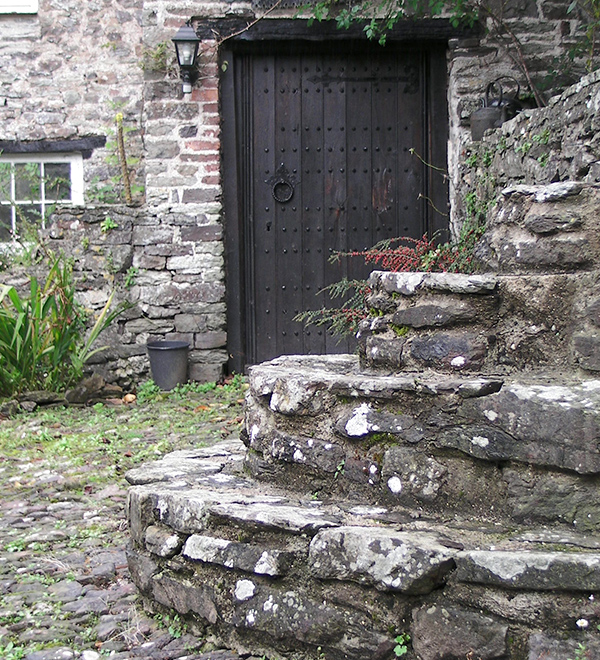

Westcott Barton is a former farm settlement, situated in a sheltered valley surrounded by rolling hills of pasture, approximately six miles north west of Barnstaple. The farmhouse and most of the buildings within the curtilage are over four hundred years old and designated as being of special historical interest.
It has been said that there has been a settlement at Westcott, in the North Devon parish of Marwood, since Saxon times. Scarce records exist to tell us more about this very early history of the site, but thereafter, Westcott (known then as West Marwood) was referenced in the Domesday Survey of 1086 as one of three manors (along with Middle Marwood and Church Marwood) and several farmsteads, namely Blakewell, Kings Heanton, Metcombe, Varley, Whiddon, Whitefield and Varley.
The Reverend Richard Powhele wrote a three volume “History of Devonshire” at the turn of the 19th century. He described Westcott (or Westcote) as the ancient residence of the Westcote family, who by the mid 13th century had adopted the name of Marwood (Merewode). According to South West Archaeology (SWARCH), Eustace de Merwode held Westcott for which he paid half a (knight’s) fee to the Barony of Torrington, and was succeeded by Walter de Merwode. In 1303, Henry de Merwode held Westcott and Pattesford (Patsford), which remained in the family’s possession.
The Marwoods had remained in residence from the reign of Henry III until the 1580s (during the reign of Elizabeth I). Early census rolls taken to determine taxation rates indicate that the Westcott estate commanded the highest valuation in the parish (Stoate, 1986).
When John Marwood died in the 1580s, he left his heritage, including Westcott and Patsford to his daughters (he had no surviving sons). His eldest daughter Elizabeth (b.1545, Westcott) married John Chichester of Hall, Bishops Tawton and thereafter, Westcott changed hands and became the family seat of Devonshire gentry, the Chichester family. Westcott and Patsford remained in the possession of the Chichesters, however when Francis Chichester died without heirs in 1698, ownership passed to his cousins. Under the terms of the inheritance, the estate could now be leased, marking the beginning of a series of tenancies.
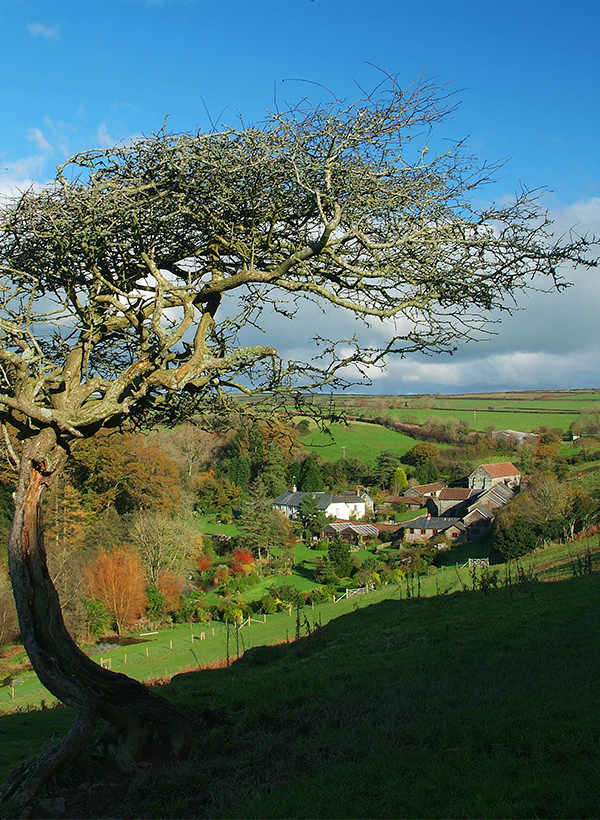
Consistent with other medieval properties of high status, a small chapel existed on the site at Westcott, evidenced by several sources. By the 18th century the chapel was said to be in ruins and today there are no obvious remains in sight. It is unknown whether the chapel was free standing or attached to an existing building, although archaeologists suggest that some intriguing lumps and bumps in the field opposite the Tithe Barn may give some clues. Such chapels (known as ‘chapel-of-ease’) were sometimes built within the boundaries of large wealthy estates, primarily for the benefit of the family in residence, but also servants and nearby villagers who would otherwise have a long trek to reach the parish church, particularly in bad weather.
Westcott also boasted two mills, which SMARCH presume were at least as early as 16th century. The first, and most notable mill was actually located at Whitehall, which was part of the Westcott estate until 1925. The location of the second mill is unclear, possibly being within the curtilage, or closer to Patsford.
SMARCH note that during the early years of the Chichesters’ possession in the 16th century there was already an elaborate residence in existence, and by the early 17th century there were a number of changes to the property, with the addition of new buildings and refurbishment of older existing structures. Further developments occurred in the 19th century, which are likely to have been affected under the tenancies of the Balsdon and Joslin families.
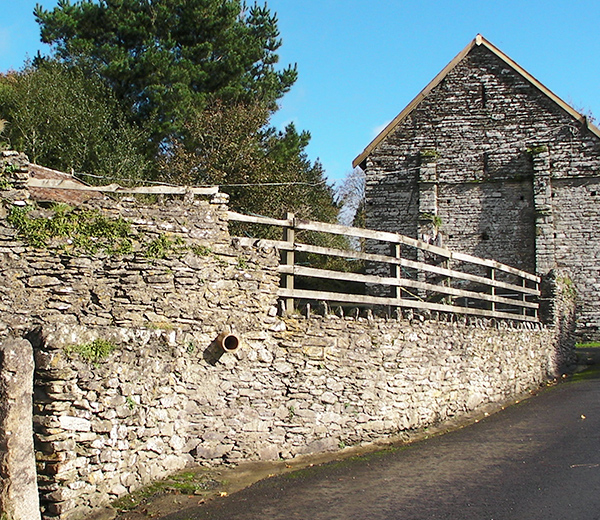
In 1819, under the ownership of Robert Chichester, Westcott was leased to a farmer named William Balsdon. At this time, yeomen managing significant farms such as Westcott, Varley and Whitefield were expected to attend Vestry meetings where important decisions were made relating to the parish matters. These men were also responsible for performing important roles such as Overseers of the Poor and Surveyor of Parish Highways. William Balsdon is frequently mentioned in Marwood Vestry minutes as taking on several roles including chairman in 1848. Balsdon was also active in the local ploughing matches, in which he acted as judge.
During Balsdon’s tenancy, the Tithe Commissioners were invited to survey all parishes in England, to record every field, area of woodland, waterway, road and building, enabling acreages to be calculated, and from this, the amount payable to the church by each household. In 1840, a Tithe Map was drawn up for each parish, with each individual plot being numbered which could then be cross-referenced against the list of tithe apportionments.
The information collected in the tithe apportionment records included:
The original tithe maps are held at the National Archives at Kew, however a copy of the Marwood parish tithe map can be viewed at the North Devon Record Office in Barnstaple.
After Balsdon’s death in 1851, his son William took on the tenancy. William junior was frequently mentioned in the North Devon Journal for various reasons during his 15-year occupancy. In 1860 he caught thieves stealing several bags of fertiliser from his barn, and pressed charges; in 1861, one of his farm servants fell from a ladder resting against a corn rick and fractured his leg, then in 1862, Balsdon himself became defendant when he was charged and convicted of ‘furiously riding’ home from the Barnstaple market, after racing through Bradiford at 11pm on a Friday night.
William junior farmed the estate until his early death in 1866, at the age of 39. Morris’ Directory of 1870 reveals that his wife Ann then managed the farm for several years following his death.
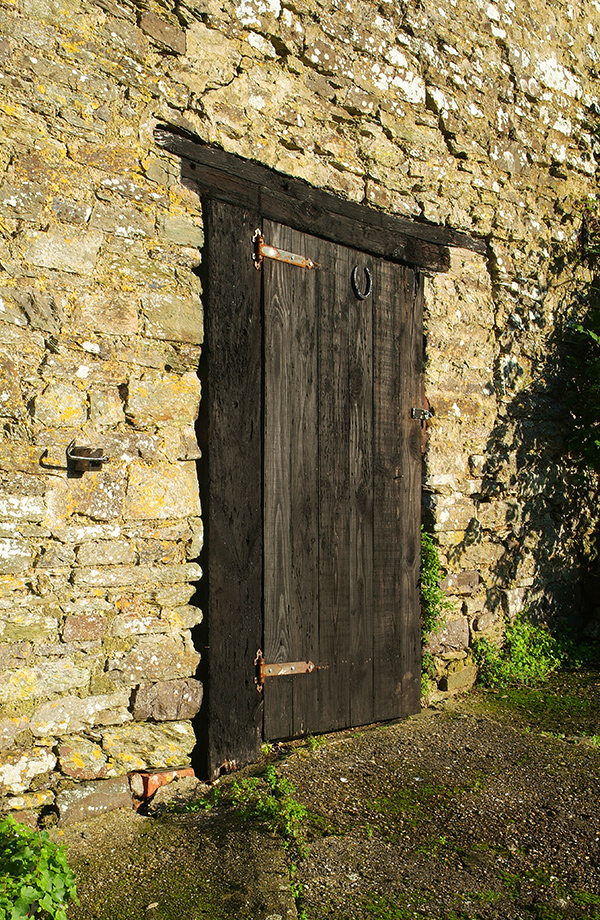
Thomas Joslin (1824-1889) took over the tenancy in 1871 at the age of forty-seven. He had formerly farmed in Kings Heanton, and latterly Westaway Farm in Pilton. With the support of his wife Elizabeth, and ten children, aged between 12 and 21, the Joslin family commenced what would eventually become a 51-year tenancy at Westcott.
Thomas died suddenly in 1889 aged sixty-five. An article in the North Devon Journal makes clear the degree of respect held for him:
“Mr Thomas Joslin of Westcott, Marwood, attended the Cattle Fair yesterday, and in the afternoon visited the Fair Ground, North Walk. He left Castle Street about four o’clock and when walking through Holland Street he fell and expired immediately. Mr J Harper, Surgeon, the medical attendant of the deceased, was at once sent for, and the body was subsequently conveyed to the North Devon Infirmary. Mr Joslin appeared to be in his usual state of health yesterday morning. The cause of death is believed to have been heart disease. Mr Joslin was well known throughout the North of Devon as a successful agriculturalist of the old school. In addition to farming Westacott, which belongs to Mr Chichester, of Hall, he retained in his own hands the adjoining estate of Beara, of which he was the owner. He farmed the Westaway estate for several years. He was a staunch Conservative and Churchman. He was one of the churchwardens of the parish of Marwood for many years, and for a long period he represented the parish on the Board of Guardians. Mr Joslin was a vigilant and conscientious guardian, and often amused the Board with his quaint and humorous remarks. He was a man of sound common sense, and was much respected. He was a great admirer of the Devon breed of bullocks, and was well known as a successful breeder. The deepest sympathy is felt for the family of the deceased in their sudden bereavement”.
North Devon Journal, Thursday 19th September 1889
Oldest son John had was already running a significant farm in Bratton Fleming, therefore second son Thomas (1850-1924) took over the tenancy.
Like his father, Thomas junior held many important roles in the parish during his occupancy. He was a member of the Vestry and when the Parish Council Act of 1894 was introduced, he was amongst the first ever councillors elected in Marwood, receiving the highest number of votes. He was also a member of the Barnstaple Board of Guardians and District Council. He regularly donated gifts to the church including a bell rope; harvest fruits, and for many years he was churchwarden at Marwood Parish Church.
The Joslins must have been fair employers because in several instances, their farm workers gave long and faithful service. At a Marwood ploughing match in 1899, Edward Pugsley of Patsford was presented with an award for his 27 yrs long service at Westcott Barton. His service had begun with Thomas senior, when he first occupied the estate, and remained working for Thomas junior for a further ten years. (His brother Charles bought Patsford Farm in 1925).
George Geen was a neighbour of Edward, and had worked all his life at Westcott Barton until his accidental death in 1904, aged 67. He had been carting mangolds to feed sheep in a field at Patsford when the mare drawing his cart suddenly bolted. George tried to secure the animal but fell and one of the wheels of the partially unloaded cart passed over his neck, and he was killed instantly.
Another faithful servant was Reuben Tamlyn of Middle Marwood, who had been in service at Westcott for 14 years until he went away to fight in the First World War. Sadly he lost his life in India in July 1915. Having lost Reuben, Thomas Joslin applied to retain two of his workers, George Windsor and Frederick Thorne, to prevent their call up. He argued that as two of his men had already joined up, and that he had 97 acres of land under the plough, these men would be impossible to replace. The outcome of the tribunal was that Thorne was allowed to stay, being the older of the two, but Windsor was to leave on October 1st 1916.
Thomas Joslin died on Tuesday 11th November 1924, having farmed at Westcott Barton for almost fifty-four years. The North Devon Journal reported that ‘widespread sorrow and regret has been caused throughout the parish of Marwood by the death of one its oldest and most respected inhabitants, in the person of Mr Thomas Joslin of Westcott Barton’. He had never married and no children to continue the tenancy.
The owner, Major Charles Chichester made the momentous decision to put Westcott up for sale for the first time in its history. Their Marwood portfolio was huge and the auction included Patsford Farm, which was described as a useful mixed farm of 96 acres, with a good slated dwelling house, tiled outbuildings, arable and pasture land (bought by Mr Charles Pugsley for £2,375); Patsford Cottage, described as a useful smallholding with 5 acres (bought by Mr Geen for £300); and various pieces of pasture and arable land. Whitehall Mills, “a desirable dairy and sheep farm of 32 acres” (bought by Mr Conibear for £1,750). The final lot of the sale was Westcott Barton; described as a most excellent cattle, sheep and corn farm of 249 acres, within a ring fence, well intersected by good roads and well watered. The sale included ‘an excellent dwelling-house, superior outbuildings and two good cottages’. The bidding stopped at £6,000 at which point the property was withdrawn. Later, private negotiations were held to try and reach a sale.
A separate auction of cattle was successful, with all the lots reaching good prices. This included fifty cattle, two hundred sheep and several horses. Tools and machinery were also auctioned, including a corn drill, binder, manure distributor, mowers, carts, hay rakes, horse hoes, ploughs, a hay rick and sacks of potatoes.
The Farmhouse furniture was also sold, including an oak kitchen table, mahogany sideboard, 9 dining chairs, mahogany dining table, barometer, glass cupboard, grandfather clocks, mahogany bedsteads and wardrobes. After over fifty years the Joslins’ tenure was finally over. In his will, Thomas left money to each of his siblings, with the remainder left to his youngest brother Joshua Joslin, who was farming at Townridden Barton.
Westcott Barton was finally sold to Adam Stanbury, only the second owner in the estate’s history. Adam (pictured right with his wife Amelia, 1945) was born in Bratton Fleming in around 1865, the son of a Thatcher. He initially worked with his brothers on a family farm in Snapper, Goodleigh; then Buttercombe, West Down.
Adam’s eldest son Mervyn managed the running of the farm until 1951 when the property was sold to William May. The May family held possession until 2003 when the current owner, Howard Frank, made the purchase.
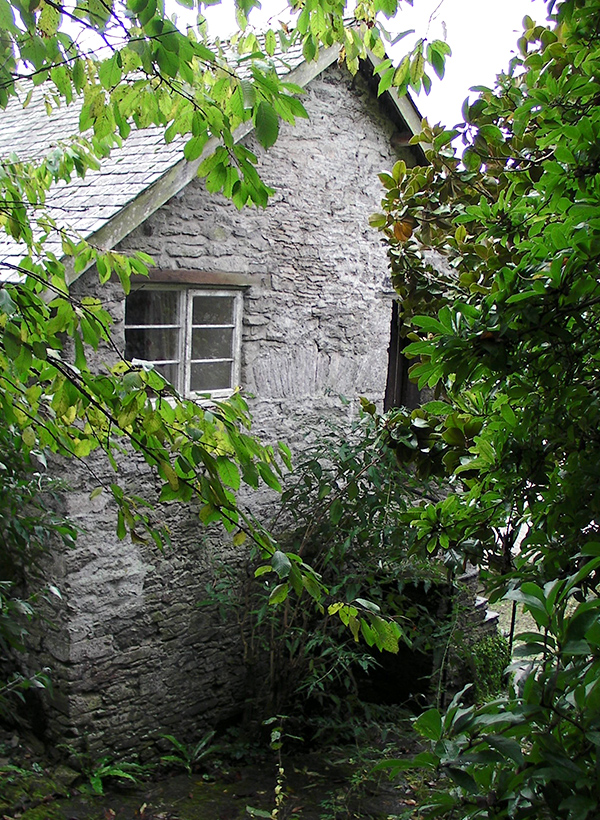
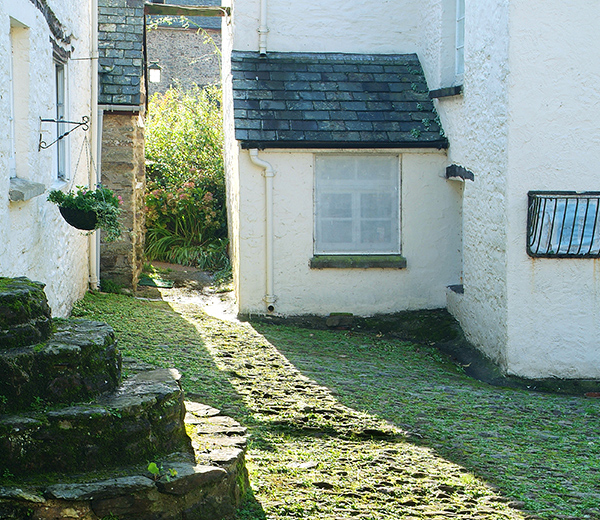
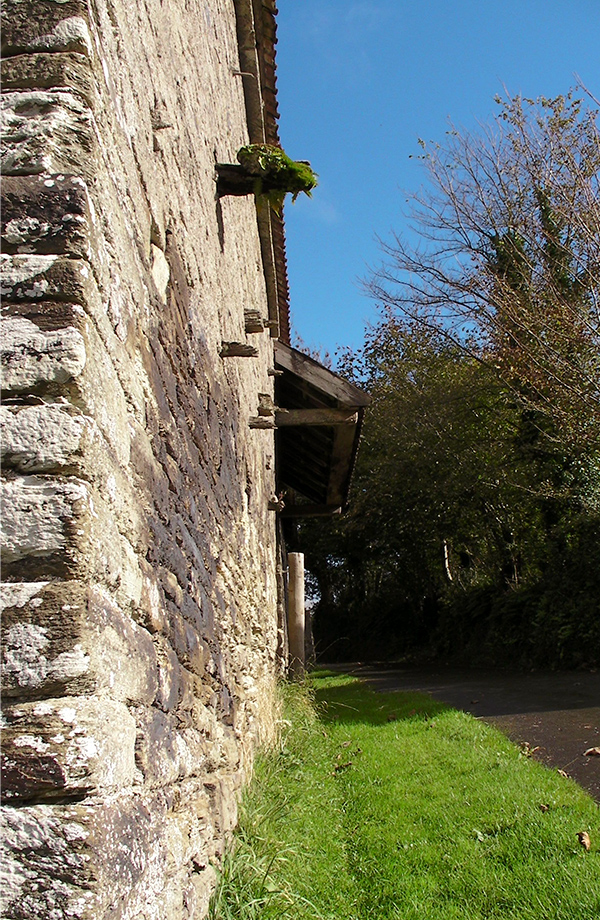
At the western end of the Marwood Parish Church, lies the fifteenth century bell tower. There is a legend associated with its origins, which mentions a laundress from Westcott. Evidently, the woman found a quantity of money hidden in the old mansion, and believed its divine purpose was to enable the construction of a tower at the parish church, which she duly arranged to be built as high as the belfry window. According to Morris’ trade directory of 1870, a figurehead of a woman was carved into the tower’s stonework on one side of the window, and an ironing box the other side, which it states ‘gives a colouring of probability to the tale’. Today these carvings are no longer visible, possibly as a result of later restoration work, which sadly leaves us with an element of doubt as to whether this was fable or fact.
Powhele, Richard Rev: History of Devonshire, 1806
Lysons Magna Britannia: volume 6: Devonshire, published 1822
North Devon Journal, articles 1826-1925
Morris’ Trade Directory, 1870
Stoate, T L: Devon Taxes, 1581-1660, Harry Galloway Publishing, 1986
SWARCH Archaeological Desk-Based Assessment & Historic Building Survey, 2007
Bowman, A: Marwood, A fond encounter with a rural Devon parish, 2011
Marwood Parish Tithe Map of 1840 – North Devon Record Office, Barnstaple
